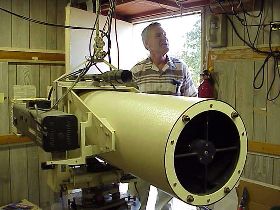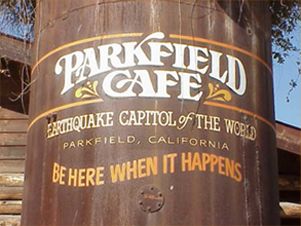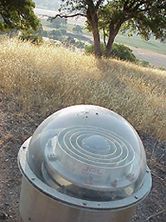
|
This
sleepy little central California town
, which sits atop the San Andreas
fault, has been hit with a magnitude 6 earthquake about every 22 years since
1857. The frequency and regularity of this quake action attracted many geologists
and research projects to Parkfield in the 1970s and 80s, all hoping to collect
data that would help us predict quakes both in Parkfield and elsewhere.
Ironically, the Parkfield "22-year quake" chose not to occur at its regular
interval in 1993, but scientists are still waitingÑmonitoring and measuring
all the while. Duane Hamman, in fact, has been taking measurements for the
USGS in Parkfield with a rare laser geodimeter (shown at right) for 14 years.
A laser geodimeter is really just an ultra-precise ruler that can measure
large distances with extreme accuracy. Here's how it works: A technician
beams laser light at one or more reflectors up to 6 miles away. The amount
of time it takes for the light to make a round trip to the reflector and
back is a function of the distance between the laser and the reflector.
Repeated measurements reveal whether the earth is changing shape. If the
light returns just a tiny bit earlier than before, it means that the two
points have moved closer together. If the light is a little late, then the
two points have moved apart. This technique is extremely accurate; it can
measure shifts in distance as small as a millimeter. In practice, measuring
distance with lasers poses some problems. The path between the laser and
the reflector must be completely clear of obstructions, and fog and rain
can block the laser beam. Also, the speed of light traveling through air
changes with the air's temperature and pressure. Accuracy demands that these
slight changes be factored into the calculations.
|

|

|

|

|













